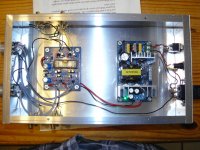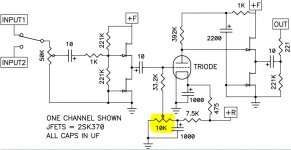Last edited:
I could not wait to see if and when a board would be available to build a preamp designed by Nelson using the Kork so I ordered the tube and buffer board from Pete Millett and installed it in a simple case. If and when a board is available in our store I will buy and build our leader's version as well. They are very similar from what I can tell but Nelson does include a constant current source and j-fets instead of mosfets. I believe 2SK170's can be used in the Millett board with just a resistor value change. I am very impressed with the sound produced by this tube using our SS amps. I own a number of SET's both SE 300B and SE 45 tube and a number of triode strapped ones as well to compare it to Fun cheap and easy to build while waiting on Nelson's board to become available. One could build just from the schematic but I will wait to see if and when a board becomes available. Right now I am using my BA-1 amp and loving the sound.
Attachments
Is 10k pot used to adjust 2nd harmonic? Should it be set in the middle at the start and then adjusted?
Are you referring to the 10 ohm pot? Primarily it is used for DC offset, but
can also adjust the 2nd harmonic a bit.
Are you referring to the 10 ohm pot? Primarily it is used for DC offset, but can also adjust the 2nd harmonic a bit.
Thank you. I am referring to the highlighted pot. Should it be 10 ohm instead of 10K?
Attachments
Papa , multitasking , mistake here and there ;
he most probably was thinking of 10R pot in between JFet sources , not existing here
so , no 10R pot there
sole one is 10K , no doubt
So, if I understand this correctly 10k pot here is used to set BIAS for the triode. Any guidance how to set it?
This tube runs in class A2. So with grid current. The grid should be biased a little above zero volts (2 or 3V).
You can check the Korg application note: Guide | Nutube – English
Nelson uses a 9V zener as base voltage. Seems high. But anyway: I would adjust the pot so the bias voltage is around 0 volt (pot fully towards ground). And now adjust so you get the current you need.
I think this tube is used around 25 uA.
You can check the Korg application note: Guide | Nutube – English
Nelson uses a 9V zener as base voltage. Seems high. But anyway: I would adjust the pot so the bias voltage is around 0 volt (pot fully towards ground). And now adjust so you get the current you need.
I think this tube is used around 25 uA.
Last edited:
So, if I understand this correctly 10k pot here is used to set BIAS for the triode. Any guidance how to set it?
You will adjust the pot for the amount and phase of the distortion you desire.
Looking at my notes on test sample, +24V supply, 17 mA heater,
332 Kohm plate, ~17 dB gain and 1 volt output:
2nd harmonic null at 11.6V plate voltage (right ch) and 11.8V left ch.
1.5% -phase 2nd with plate voltage = 9.0V
1.5% +phase with plate voltage 13.5V.

You will adjust the pot for the amount and phase of the distortion you desire.

Mmm. Getting a distortion analyzer / FFT device seems a necessity these days.
I only have an old analog scope.
If I understand it correctly, you use the bias to set the internal resistance of the tube (same as fet). With this, you can choose how much voltage will drop over the anode load and how much voltage will drop over the tube.
I case of a 50/50 share, the distortion is almost zero. If the tube is having a bigger share, the distortion is positive.
You will adjust the pot for the amount and phase of the distortion you desire.
Looking at my notes on test sample, +24V supply, 17 mA heater,
332 Kohm plate, ~17 dB gain and 1 volt output:
2nd harmonic null at 11.6V plate voltage (right ch) and 11.8V left ch.
1.5% -phase 2nd with plate voltage = 9.0V
1.5% +phase with plate voltage 13.5V.

Brilliant, thanks a lot.
Mmm. Getting a distortion analyzer / FFT device seems a necessity these days.
I only have an old analog scope....
Since you have a scope, for diy purpose, distortion analyzer is not neccessary. A simple 1khz sinewave oscillator and Twin T notch filter is adequate to be able to adjust the pot targeting a specific amount and phase of H2 distortion. For FFT you can use a PC soundcard software with FFT function such as donationware Christian Zeitnitz's Soundcard Ocilloscope.
For Pass diyer, some fine tuning such as described for F5, F6 and the Korg B1 need real time viewing of distortion residual. I believe that currently, though not simple, a scope and notch filter is the way to go. Some USB scope software have no option for real time view of distortion residual. Generg had experience posted last year on Time-view of distortion residual thread with Virtins system involving non real time data save and conversion. You may want to look into this a little deeper.
The BitScope Micro should be real time spectrum analysis too.
BitScope Micro Model 5 | A tiny USB Mixed Signal Oscilloscope
BitScope Micro Model 5 | A tiny USB Mixed Signal Oscilloscope
...I case of a 50/50 share, the distortion is almost zero. If the tube is having a bigger share, the distortion is positive.
Very well said.
I don't know that the "+" and "-" harmonic phases will sound very different?
The ear can hear. Find a Sine source with <1% THD. If you only have a function generator, low-pass the heck out of it. (The "sine" on basic function generators is ripe with high harmonics, which will distract/annoy the ear.) Anywhere 400Hz to 1KHz.
You need to adjust the level into the NuTube box, and out of the NuTube box. Adjustable source, and power amp with level control.
With power amp down, low speaker loudness, bring level up until the NuTube goes SPLATTT. Bias the NuTube for loudest splatt, a close approximation to a max-output bias. Mark the bias pot. That's hard overload. We don't want to go here again.
We do want to be maybe half that level, so we are well up on distortion. Bring the level down to half that loud. (Readjust power amp if too soft to hear clear.)
Now turn the bias pot one way and the other. At either extreme it craps-out (technical term). Around the middle it is very "pure". Off-middle there is an octave overtone, "sweet".
If you spend some years around a modular synthesizer, you can "read" a sound like an Eskimo reads snow. Beginners may have to try a while, take a break for a day, and listen again, to hear the sound quality and where it gets "pure" or "sweet" or "sour". It probably takes a lot longer to know exactly when the sound is "as pure as it gets". Of course if we wanted that there are many fine ways to do "pure pure". I think the point of hot vacuum is "a little off-pure".
Hi PRR,
In your experience, did you find optimum bias setting for "as pure as it gets" sound speaker dependent or relatively fixed? I believe Srajan Ebaen on page 5 of 6Moons SIT1 review found subjective optimum bias setting to be speaker dependent when he tried a DHT preamp with SIT1 combo. I quoted "With each SIT preceded by just one premium dead-quiet 10Y, now the sonic changes of the amp's bias adjustments had been stretched to profound. Forget any prior subtle."
In your experience, did you find optimum bias setting for "as pure as it gets" sound speaker dependent or relatively fixed? I believe Srajan Ebaen on page 5 of 6Moons SIT1 review found subjective optimum bias setting to be speaker dependent when he tried a DHT preamp with SIT1 combo. I quoted "With each SIT preceded by just one premium dead-quiet 10Y, now the sonic changes of the amp's bias adjustments had been stretched to profound. Forget any prior subtle."
- Home
- Amplifiers
- Pass Labs
- B1 with Korg Triode

